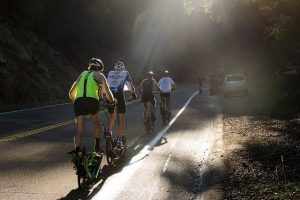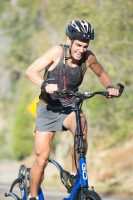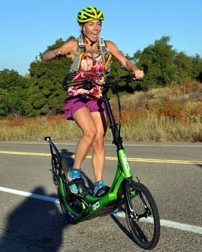You’ve qualified and you’ve entered to ride in the World Championships of Elliptical Cycling. Or, maybe you’re thinking about qualifying next year to join the race up Palomar Mountain. Either way, you find yourself asking, “Now what?”
 You’ve trained for races before, and you love riding your ElliptiGO bike in cycling events, but you’re still wondering, “How do I prepare to climb 4209ft across 11.69mi at a steady average grade of over 7% … and survive?” Or maybe you live in a flat area and wonder if you can even train for this race? Well, lucky for you, we’ve done this race a time or two and can provide a few quick tips on training for the event, no matter whether you live in the mountains, on the flat plains or along the coast.
You’ve trained for races before, and you love riding your ElliptiGO bike in cycling events, but you’re still wondering, “How do I prepare to climb 4209ft across 11.69mi at a steady average grade of over 7% … and survive?” Or maybe you live in a flat area and wonder if you can even train for this race? Well, lucky for you, we’ve done this race a time or two and can provide a few quick tips on training for the event, no matter whether you live in the mountains, on the flat plains or along the coast.
The first thing to understand is that those higher gears you are used to riding in will go relatively unused, as the course’s route starts on an incline and doesn’t let up for the entire ascent – aside from a small 600m stretch in the middle. For most riders, the entire climb will be spent between 1st and 4th gears. Those on an 11R may find that they are able to use 5th gear for a portion of the climb, but I’d advise against using too-high of resistance, as it will burn up your leg muscles much faster than a quick cadence will.
Think of it as the difference between running a 100m sprint and running a half-marathon. In a 100m sprint, runners will take much more powerful, explosive strides, while in a half marathon, the key is to conserve energy with each step, expelling it evenly across the entire duration of the race. In fact, the ascent up Palomar tends to be relatively close in both duration and physical feeling to running a half marathon – but without the resulting joint-ache from impact. Because of this, hydration and nutrition strategies, as well as dress – which we will touch on below – tend to be similar.
So how do you prepare for such a long climb? Here are a few sessions and tips to help you get in proper form:
Long Hills/Climbs
Sport specificity is a known principle that says the best way to prepare for something is by doing exactly that. You wouldn’t prepare to play baseball by swinging a tennis racquet and, likewise, wouldn’t prepare to swim by jumping on a pogo stick. That said, when you simply can’t match specificity, the goal becomes to get as close as possible to the stimulus required for that activity. If you don’t live in the southern California area, and can’t climb Palomar regularly, I recommend looking for similar climbs in your area.
We’ve written up a profile and description of The Course, and activity-tracking sites, like Strava, can be a good tool for finding other similar rides in your area. That said, if a long extended climb like Palomar doesn’t exist in your area, do what you can to break it down into sections. Do you have a two-mile climb that matches a section of the course? Do repeats up it and use the coast back down as your recovery. Doing 8-16 miles worth of climbing in total will be a pretty good substitute for the extended climbing effort of Palomar.
Hill Sprints
 Many people don’t live in an area with a long, gradual climb like Palomar. That’s ok; you can still build the power and strength necessary to be able to conquer the mountain. Shorter hill sprints in a moderate-resistance gear will provide valuable muscle-building stimulus and prepare your legs for the effort needed to reach the top. These repeats don’t have to be long (:20-:40sec in duration), but should be numerous in quantity and create quite a bit of fatigue by the end. This may mean doing upwards of 20-30 repetitions – depending on how long your incline is.
Many people don’t live in an area with a long, gradual climb like Palomar. That’s ok; you can still build the power and strength necessary to be able to conquer the mountain. Shorter hill sprints in a moderate-resistance gear will provide valuable muscle-building stimulus and prepare your legs for the effort needed to reach the top. These repeats don’t have to be long (:20-:40sec in duration), but should be numerous in quantity and create quite a bit of fatigue by the end. This may mean doing upwards of 20-30 repetitions – depending on how long your incline is.
If your area is completely flat, bridges and parking garages can sometimes provide an opportunity to get the incline you’re looking for. Get creative, but above all, be safe!
Tempo Rides
Uninterrupted rides of 40+ minutes – or repeated 20-minute rides with less than 5 minutes rest in between – in a high-resistance gear, and at 70-80% of your max heart rate, will build both the strength in your legs for the climbing, as well as the aerobic capacity to conquer the distance. For these sessions, it will be imperative to gauge your effort cautiously. What might seem easy in the beginning can often become too much to handle by minute 15.
Also, while cadence isn’t the most important part of this workout, you don’t want to be in such a high gear that your turnover falls below 40 strides per minute. Keep the tempo honest and select a gear accordingly based on your intended duration. You’ll see progress when you are either able to increase your turnover for a specific gear or are able to increase your gearing without sacrificing turnover.
Flatlanders
If you are a flatlander, while you will still be able to use the Tempo Ride and Hill Sprint techniques listed above, you will also need to prepare to tackle Palomar using endurance rather than power to ascend. Flatlanders will likely use one gear lower (e.g., 1-3 vs. 2-4) than riders who eat a steady diet of hills during training.
It will be important to practice maintaining a higher turnover to create the same amount of power and propulsion as your hilly compatriots. While you will not need to use 1-3 on flatlands during training, I would start using 1-2 gears lower than your “typical” flatland setting (i.e.,gears 8-9 if you usually ride in 10-11 on your 11R or gears 6-7 if you usually ride in 7-8 on your 8C). This will get your body used to the higher cadence over extended periods of time and build the muscle-memory required to physically and aerobically conquer Palomar.
Over-Distance Rides
Lastly, as mentioned, the climb up Palomar has an uncanny resemblance to racing a half marathon. The duration of the climb (time-wise and distance) tends to be very similar to what a person still running will put forth as a half-marathon performance. Because proper half marathon training will incorporate over-distanced runs to prep the body’s fueling system, I also recommend putting in some rides of 2-3hrs to help teach the body how to effectively use its fuel.
The best part is, because ElliptiGO bikes eliminate the impact of repeated pounding, these sessions won’t leave you feeling beat up physically. But they may leave you ravenous for food. Therefore, this will also be a good time to practice nutrition – both what you are going to take and how you are going to take it – one-hand riding, nutrition pack, aero-bottle and long straw, etc. There is a small break at the mid-point where you can pull off and fuel up, but if you want to keep momentum, I recommend one of the other approaches.
That’s it for training advice, but here are some other small tips that you should prepare for in your training leading-up because, as they say, “nothing new on race-day.”
Apparel
For apparel, I recommend waiting until a little closer to race-day to look at the weather. That said, you can learn a lot about how your body reacts to certain temperatures by playing around with layering and varying clothing options on training rides. Like a half marathon, you will want to be a little cool at the start, but as both your body and the air temperatures warm-up, you don’t want to find yourself over-heated. You also need to account for wind-chill, so if you are cold before the start, you’re likely going to be under-dressed for the first few miles.
Generally, most will ride in shorts and some sort of tech top. A few will wear long-sleeves if it’s crisp, but I’d definitely recommend wearing it as a very light outer layer that can be removed if you do. There’s a small stretch of flat riding about halfway up that serves as a good place to drop any gear you don’t want to wear for the second half of the climb. Before you drop it completely though, remember, it can be cool at the start, warmer in the middle and cool again at the top – as you do climb 4209 feet in total elevation. Think about wrapping it around your waste or storing it on your bike before tossing it aside.
For shorts, we have people ride in everything from running shorts to board-shorts to half tights and compression gear. Just remember, there’s no need for padded shorts because you aren’t going to be sitting any time during this race. You wouldn’t wear them to run a half marathon … would you?!
Nutrition
Everybody is different when it comes to nutrition, and your individual body makeup plays a big role in determining what you need for a given effort. As has been said above, I recommend relating the effort of climbing Palomar to “racing” a half marathon, not just running for that amount of time. Based on the research we have done and the metabolic response we found the body goes through at those efforts, we know that you will burn fuel at a much faster rate than a casual (or flat) long ride. Because of this, I recommend following the same protocol you would use if doing a race of 2-to-2.5 hours. This goes for pre-race fueling and in-race fueling.
We will have a rest area at midway, but mainly just to provide replacement water. Definitely grab some water there if you are out, but I wouldn’t wait till this point to begin taking in water. We will have more at the top, but likely you will want to take in much more before you get there. Remember, if you feel yourself getting hungry or thirsty, it’s probably too late. Take in nutrition and hydration early and often. That leads me to my last point: Practicing riding one-handed. We even have an online video that can help you learn how.
Race Structure
 Athletes will be gathered in waves based on qualifying time and expected finishing time. This will ensure that groups are able to ride together and race as they ascend the mountain. Use the opportunity to get in line, get into a rhythm and play a game of follow-the-leader. Not only will it help you pass the time, but the drafting will conserve energy for the final push at the top. We will start waves every 30min, with the slowest riders starting first. The Elite men will be the last to start.
Athletes will be gathered in waves based on qualifying time and expected finishing time. This will ensure that groups are able to ride together and race as they ascend the mountain. Use the opportunity to get in line, get into a rhythm and play a game of follow-the-leader. Not only will it help you pass the time, but the drafting will conserve energy for the final push at the top. We will start waves every 30min, with the slowest riders starting first. The Elite men will be the last to start.
This provides not only the safest approach to an event like this, but also allows everybody to finish in the closest proximity at the top for the post-race “relief celebration!” and ride back down (for those who wish) – and trust me, the ride down is the fun part! You actually get to enjoy the fabulous scenery that way.


One Response
[…] myself a connoisseur of writing haikus whilst aqua jogging) but the elliptiGO website included some training tips that I CERTAINLY should’ve taken more […]